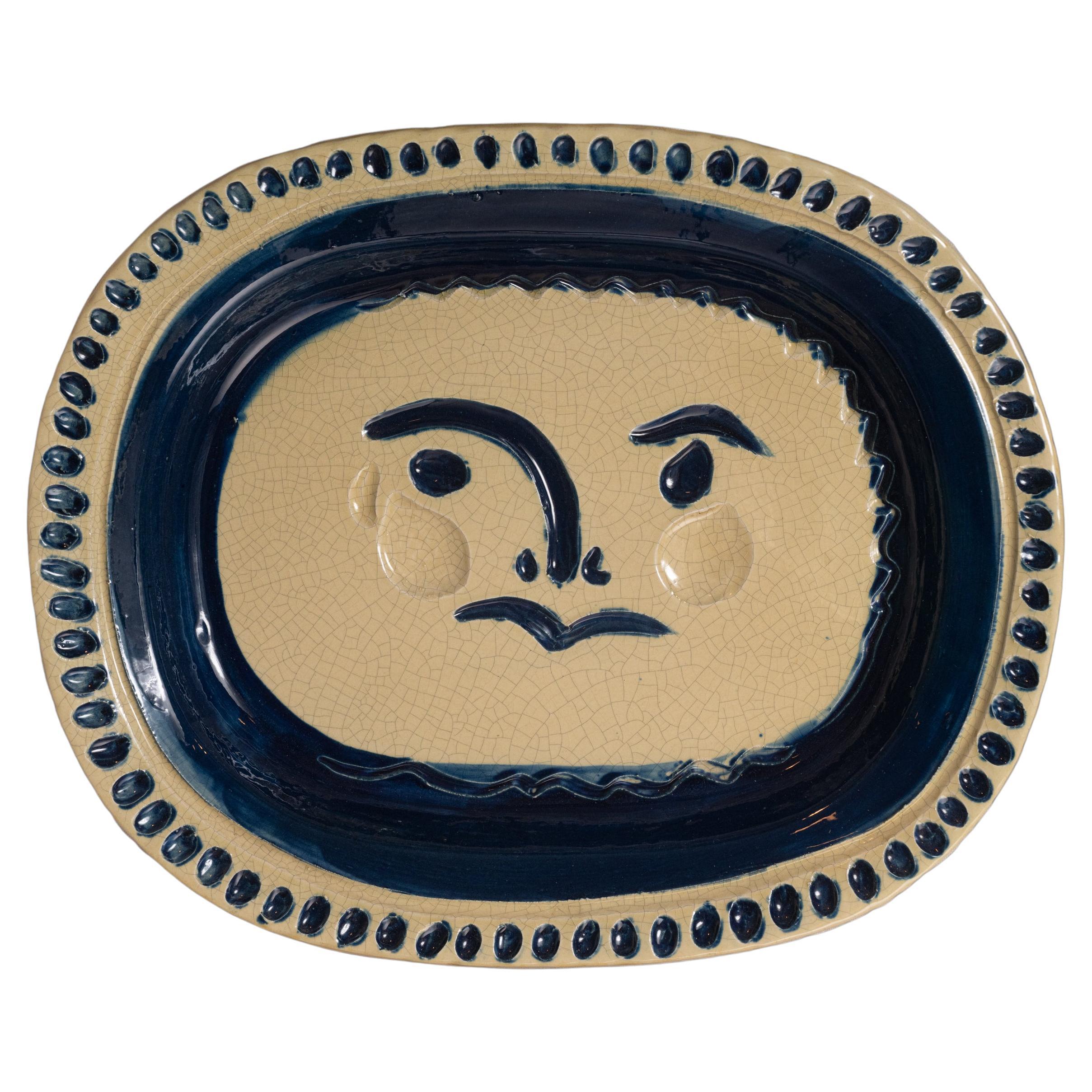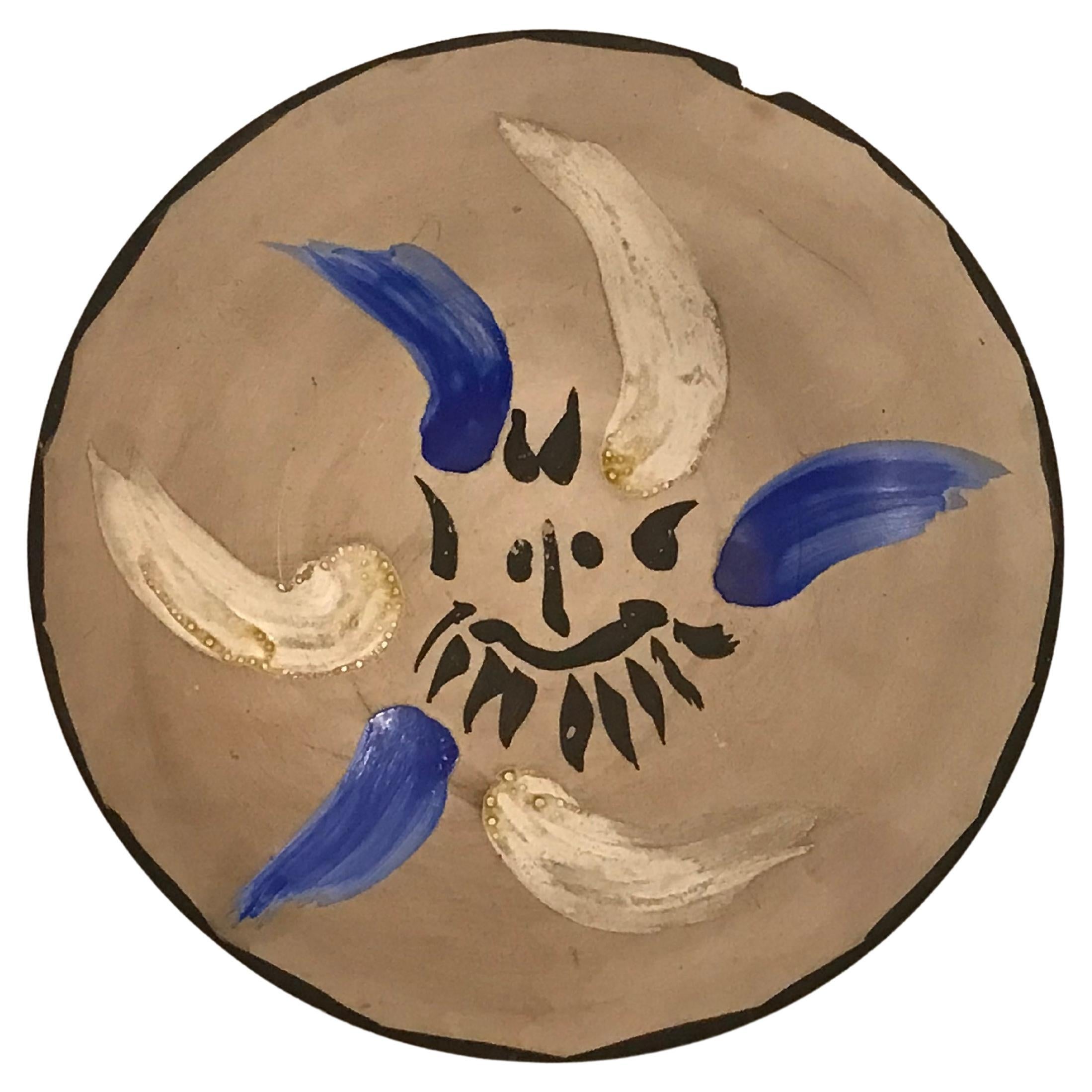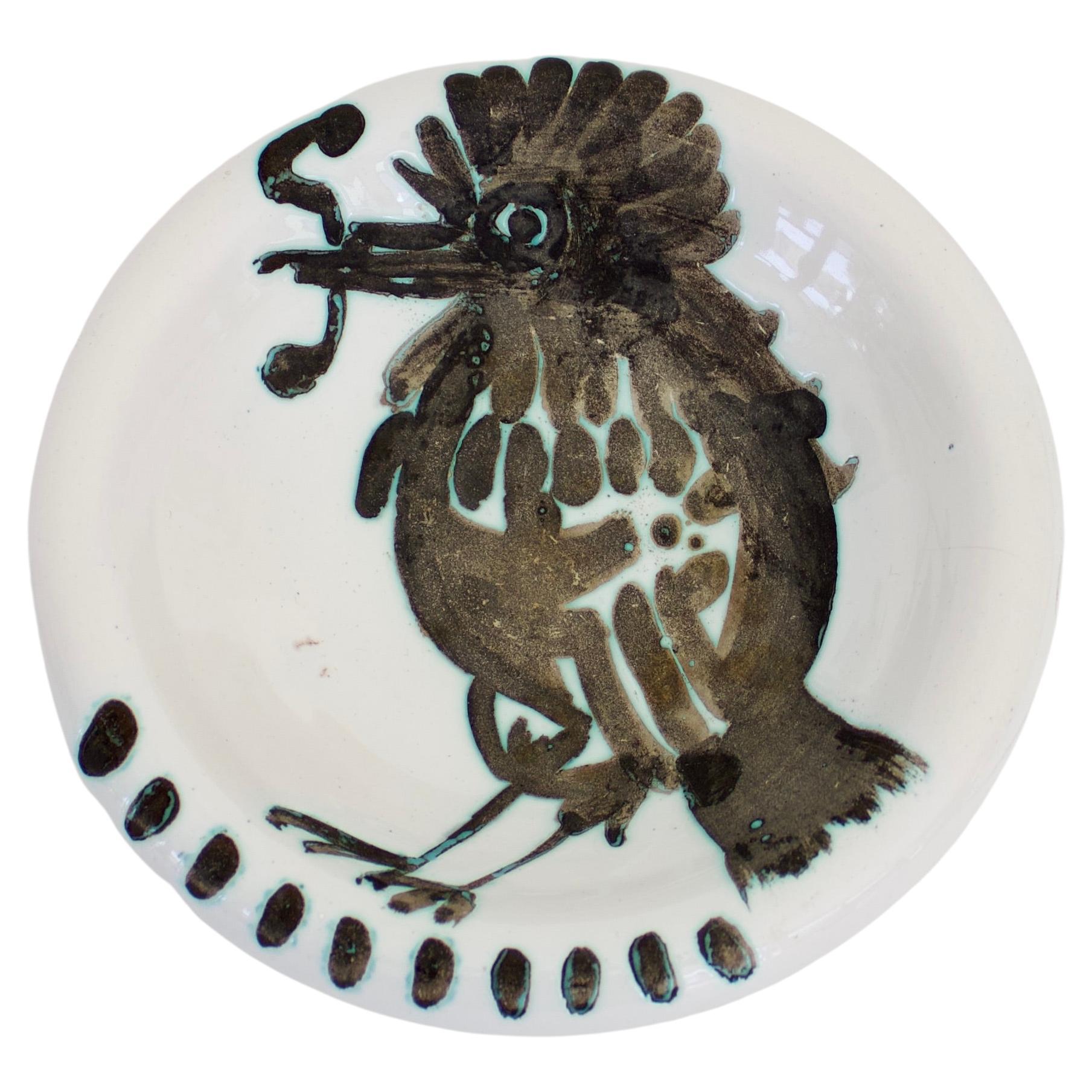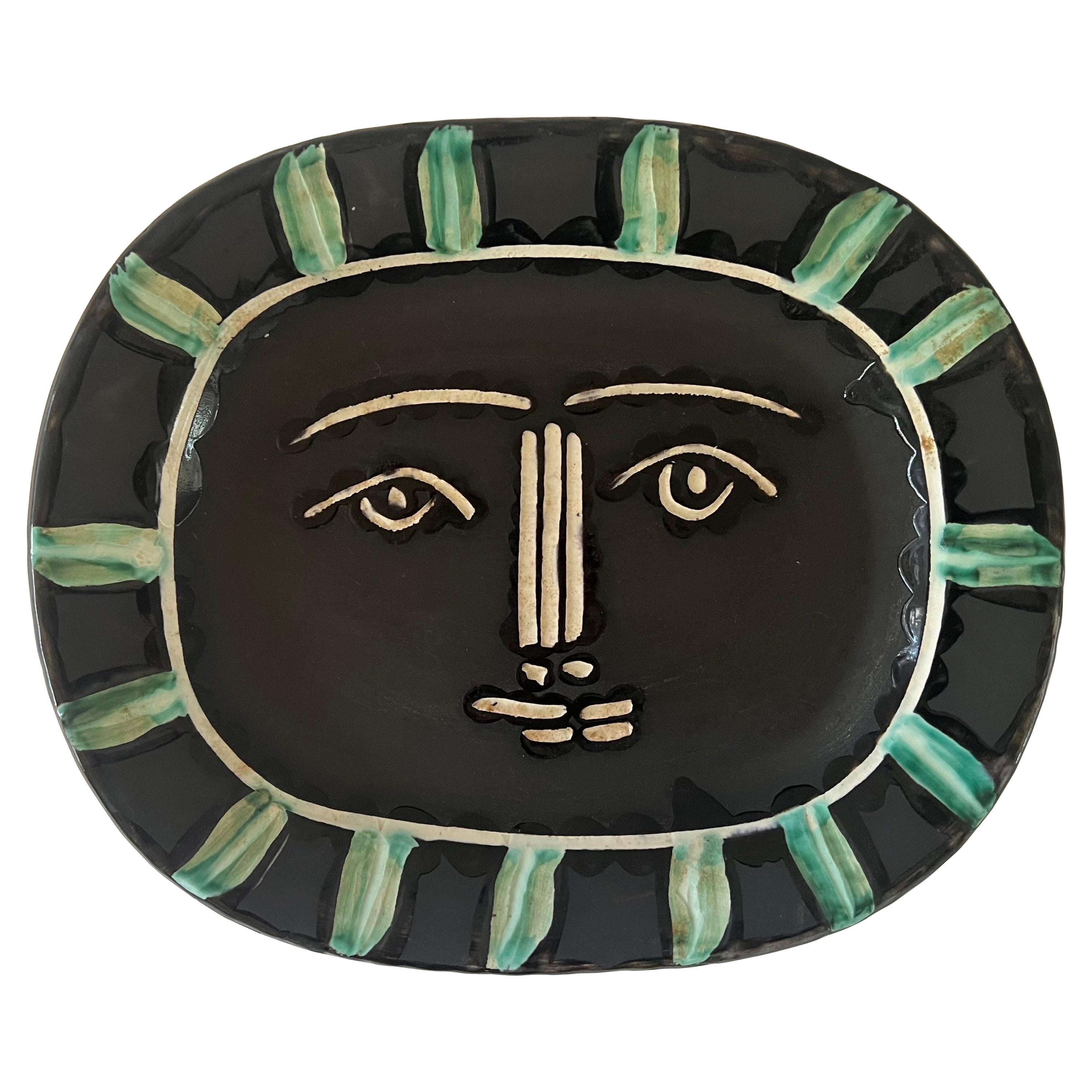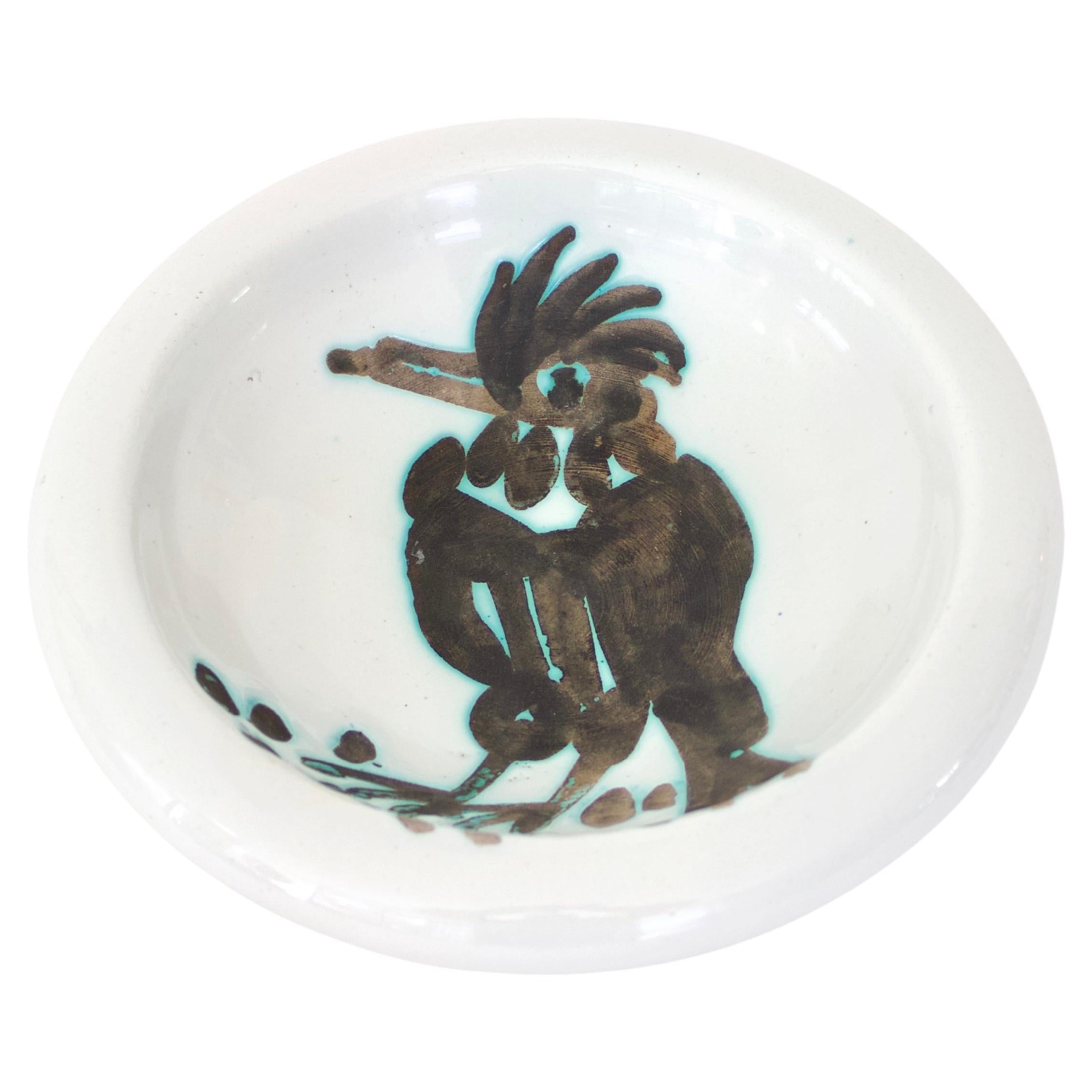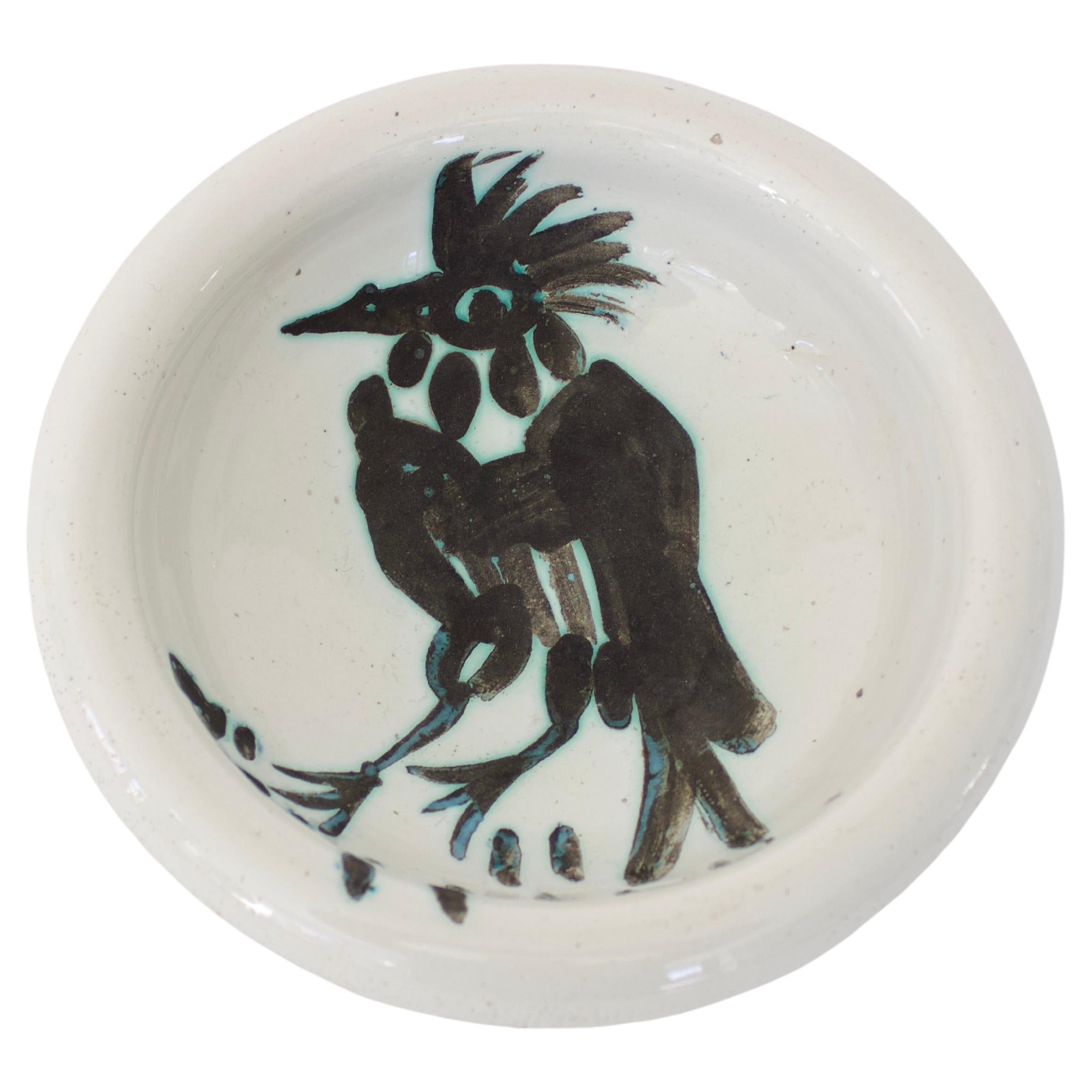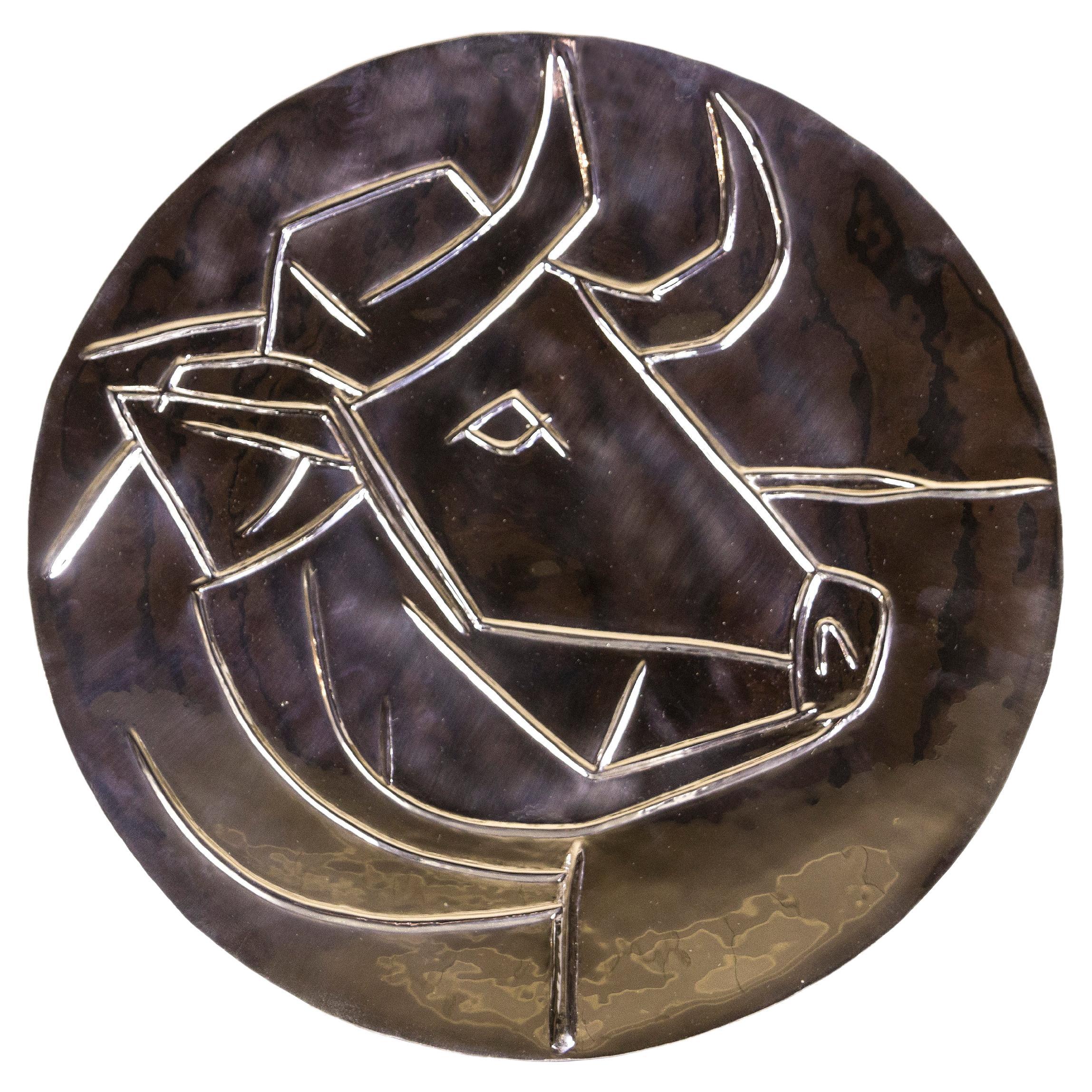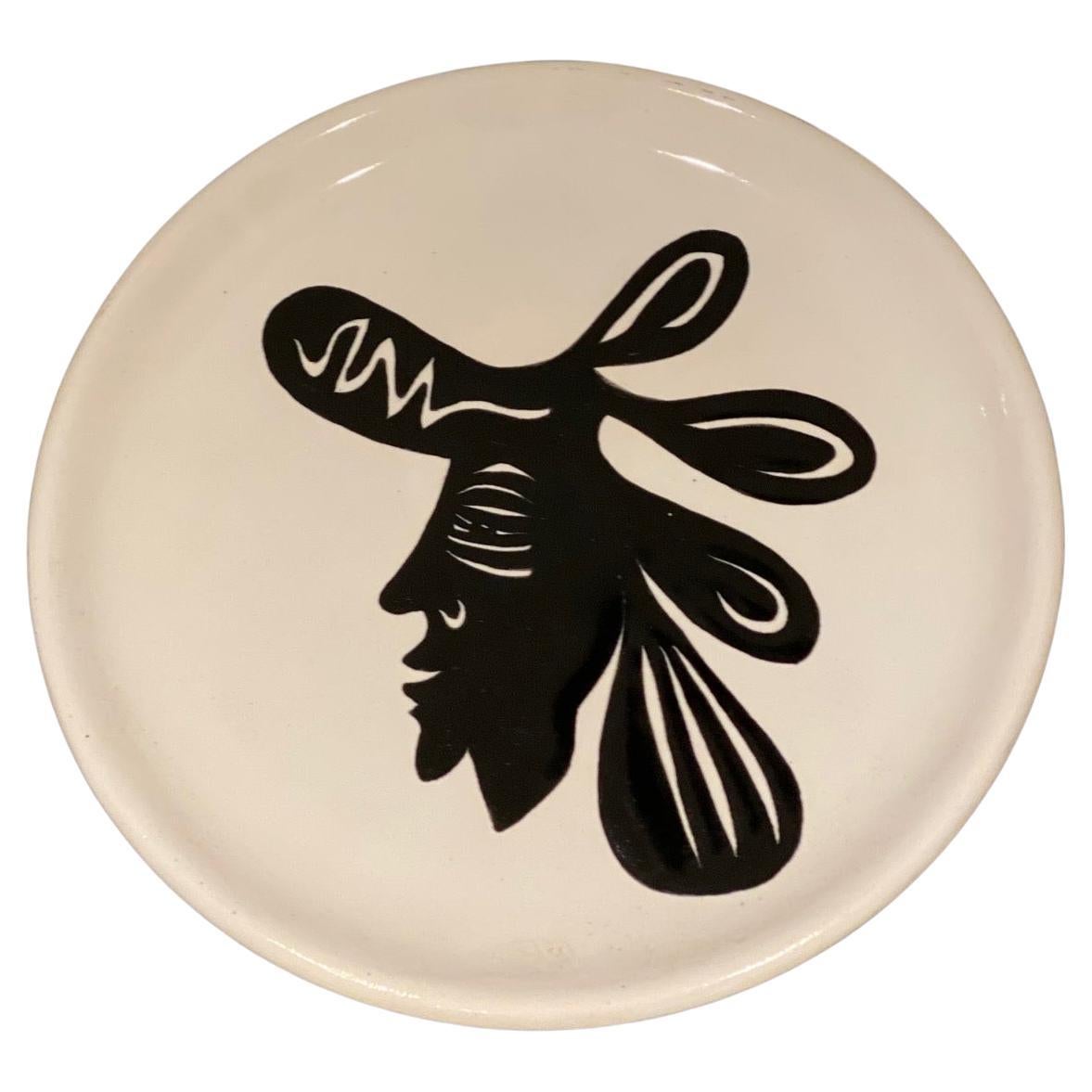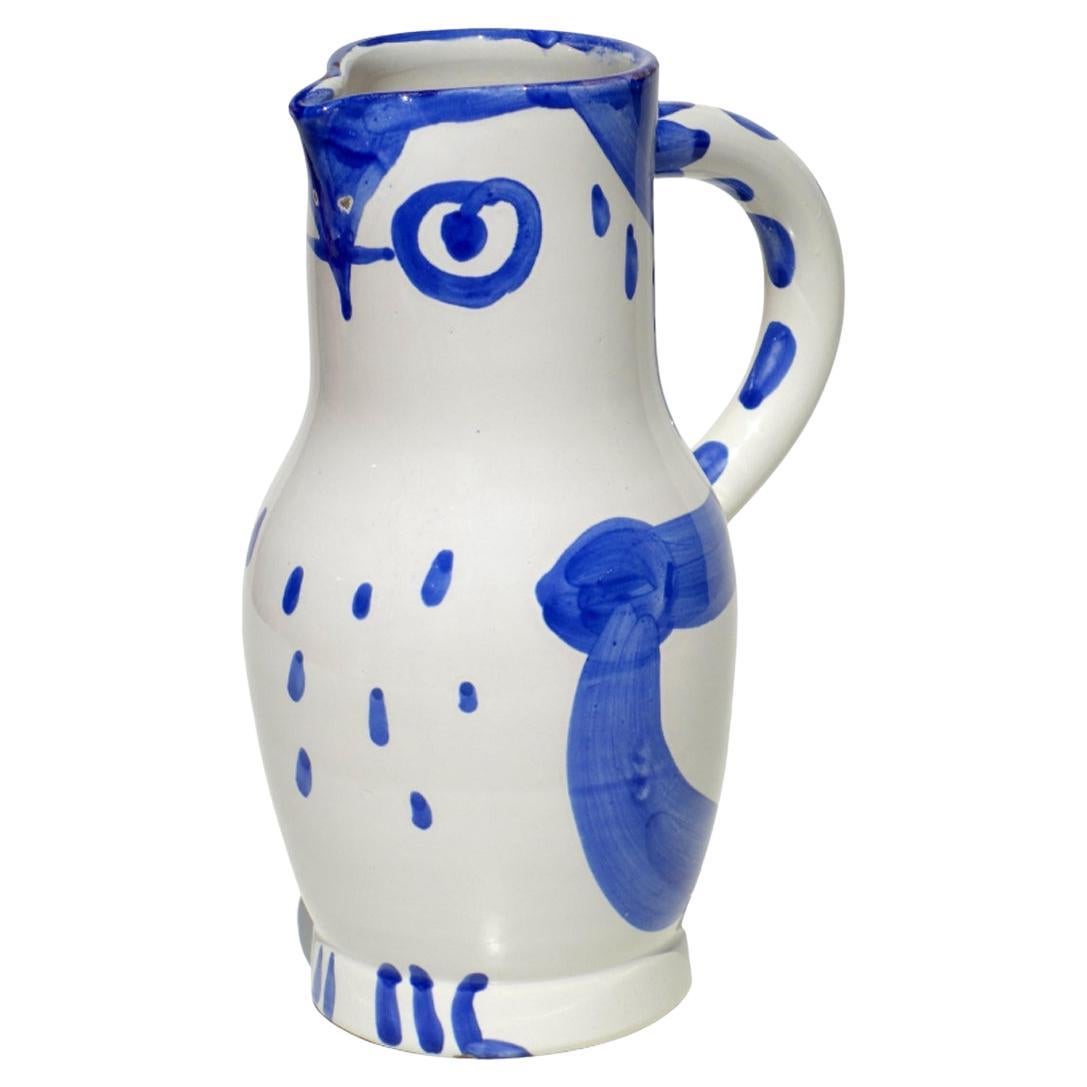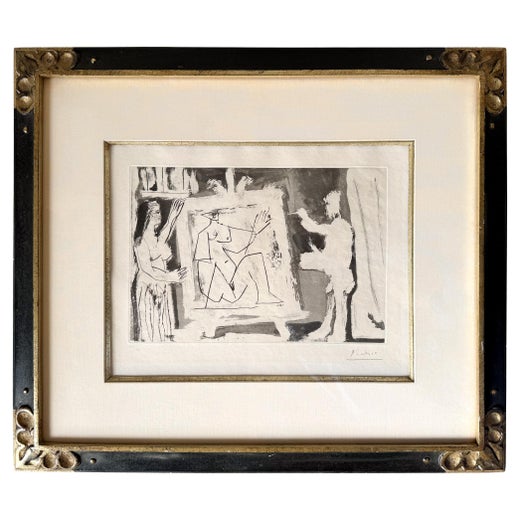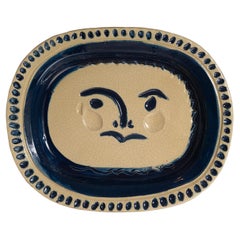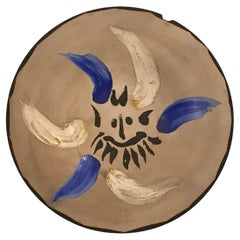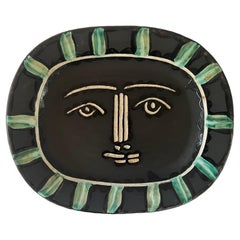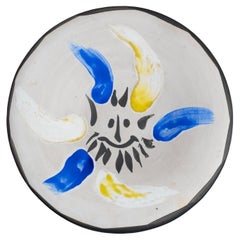
"Little Face no. 12" decorative plate by Picasso Madoura
View Similar Items
"Little Face no. 12" decorative plate by Picasso Madoura
About the Item
- Creator:Madoura (Workshop/Studio),Pablo Picasso (Artist)
- Dimensions:Height: 1 in (2.54 cm)Diameter: 9.8 in (24.9 cm)
- Style:Mid-Century Modern (Of the Period)
- Materials and Techniques:Earthenware,Glazed
- Place of Origin:
- Period:
- Date of Manufacture:1947
- Condition:Wear consistent with age and use.
- Seller Location:Chicago, US
- Reference Number:1stDibs: LU7300237175972
Pablo Picasso
One of the most prolific and revolutionary artists the world has ever seen, Pablo Picasso had a tremendous impact on the development of 20th-century modern art. Although he is best known for his association with the Cubist movement, which he founded with Georges Braque, Picasso’s influence extends to Surrealism, neoclassicism and Expressionism.
“Every act of creation is, first of all, an act of destruction,” the Spanish artist proclaimed. In Picasso's Cubist paintings, he emphasizes the two-dimensionality of the canvas, breaking with conventions regarding perspective, foreshortening and proportion. Picasso was inspired by Iberian and African tribal art. One of his most famous pre-Cubist works is Les Demoiselles d’Avignon (1907), a painting considered immoral and shocking at the time for its depiction of nude women whose faces resemble Iberian tribal masks.
Picasso made many portraits in this style, most often of the women in his life, their expressively colored faces composed of geometric shards of surface planes. In Woman in a Hat (Olga), 1935, he painted his first wife as an assemblage of abstract forms, leaving the viewer to decipher the subject through the contrasting colors and shapes. Picasso was a tireless artist, creating more than 20,000 paintings, drawings, prints, ceramics and sculptures. Tracing his life’s work reveals the progression of modern art, on which he had an unparalleled influence.
Browse an expansive collection of Pablo Picasso's art on 1stDibs.
- Engraved Face Plate by Pablo Picasso for MadouraBy Madoura, Pablo PicassoLocated in Chicago, USEngraved Face Plate by Pablo Picasso for Madoura.Category
Vintage 1940s French Mid-Century Modern Decorative Bowls
MaterialsEarthenware
- Art Nouveau Organism Bowl by ZsolnayBy ZsolnayLocated in Chicago, USZsolnay bowl with their "peacock" eosin-glaze. Zsolnay introduced its patented shiny metallic glaze, known as eosin, in 1893. The small family ceramics workshop begun in Pecs, Hunga...Category
Antique Early 1900s Hungarian Art Nouveau Decorative Bowls
MaterialsEarthenware
- Art Nouveau Porcelain Sunburst Vase by Emile DifflothBy Emile DifflothLocated in Chicago, USStriking bowl with crystalline iridized glaze. Émile Diffloth (1856 – 1933) was a French ceramicist who was born in Couleuvre. He received his education at the École des Arts Déco...Category
Antique Early 1900s French Art Nouveau Decorative Bowls
MaterialsPorcelain
- Arts & Crafts Hand-Thrown Peacock Bowl by Frederick RheadBy Frederick RheadLocated in Chicago, USHand-thrown Peacock Bowl by Frederick Rhead. Decorated in cureta seca. Potter at wheel stamp incised "RHEAD".Category
Vintage 1910s American Art Nouveau Decorative Bowls
MaterialsEarthenware
- Monumental Amphora Art Nouveau Bowl w/Saurian by Eduard Stellmacher & Co.By Eduard StellmacherLocated in Chicago, USModel #13 Eduard Stellmacher and Co, Porzellanfabrik und Kunstkeramische Industriewerke Driven to establish a new company that produced luxury porcelain and ceramic items based on his own aesthetic aspirations, Stellmacher left Amphora when the workshop was at its most prosperous, in 1904. Together with entrepreneur Karl Frank, who provided the financial backing, he founded Ed. Stellmacher & Co. in Turn-Teplitz in 1905. From the outset, Stellmacher worked hard to achieve a major position among other high-end ceramic art producers. He believed the success of the company would depend on his products of “appropriate methods and unerring quality, perfect from both the technical and artistic sides”. Stellmacher based his first collection on artistically progressive products, pieces he believed would be in high demand. The greater part of the designs were either large vases complemented with sculptures of fantastic dragons or natural animals. With this series, Stellmacher continued the themes he had created for Amphora from 1899-1902, however, his naturalistic renderings of animals was even more elaborately precise. He developed a special ceramic material called refined earthenware, which minimized the shrinkage that was common during firing and allowed for greater preservation of details in the original models. Unfortunately, by 1905, contrary to Stellmacher’s plans, there was little to no demand for objects of this type. Very few pieces exist today as very few were originally produced. Even after redirecting the company to produce commercial goods Stellmacher still could not ward off the company’s demise. By 1910 the Stellmacher & Co. fell into bankruptcy and was liquidated. Art Nouveau Dragon...Category
Antique Early 1900s Austrian Art Nouveau Decorative Bowls
MaterialsEarthenware
- Monumental Amphora Art Nouveau Vase w/Saurian by Eduard Stellmacher & Co.By Eduard StellmacherLocated in Chicago, USModel #2 Eduard Stellmacher and Co, Porzellanfabrik und Kunstkeramische Industriewerke Driven to establish a new company that produced luxury porcelain and ceramic items based on his own aesthetic aspirations, Stellmacher left Amphora when the workshop was at its most prosperous, in 1904. Together with entrepreneur Karl Frank, who provided the financial backing, he founded Ed. Stellmacher & Co. in Turn-Teplitz in 1905. From the outset, Stellmacher worked hard to achieve a major position among other high-end ceramic art producers. He believed the success of the company would depend on his products of “appropriate methods and unerring quality, perfect from both the technical and artistic sides”. Stellmacher based his first collection on artistically progressive products, pieces he believed would be in high demand. The greater part of the designs were either large vases complemented with sculptures of fantastic dragons or natural animals. With this series, Stellmacher continued the themes he had created for Amphora from 1899-1902, however, his naturalistic renderings of animals was even more elaborately precise. He developed a special ceramic material called refined earthenware, which minimized the shrinkage that was common during firing and allowed for greater preservation of details in the original models. Unfortunately, by 1905, contrary to Stellmacher’s plans, there was little to no demand for objects of this type. Very few pieces exist today as very few were originally produced. Even after redirecting the company to produce commercial goods Stellmacher still could not ward off the company’s demise. By 1910 the Stellmacher & Co. fell into bankruptcy and was liquidated. Art Nouveau Dragon...Category
Antique Early 1900s Austrian Art Nouveau Decorative Bowls
MaterialsEarthenware
- Ceramic Plate Picasso MadouraBy Pablo PicassoLocated in Los Angeles, CA1881 - 1973 What can I say about Picasso that hasn't already been written...? Only that I'm an admirer of an artist with so much passion and dedication. From the estate of the late Naomi Caryl Hirshhorn, daughter of the late art collector Joseph H. Hirshhorn of the 'Hirshhorn Museum and Sculpture Garden'. Selling "as is". Some chips and a crack. It can be restored or left as is for historical aesthetics or integrity like an old Etruscan piece of pottery. Ceramic with white glaze on the bottom with hallmarks, bisque glaze on top with painterly brush...Category
Mid-20th Century French Mid-Century Modern Decorative Dishes and Vide-Poche
MaterialsCeramic
- Pablo Picasso Ceramic Dish Editions Picasso Madoura Bird With With Worm 1952By Pablo Picasso, MadouraLocated in Chicago, ILPablo Picasso Oiseau Bird with worm in mouth dish editions Picasso Madoura France. Circa 1952. Impressed with mark to underside Madoura Plein F...Category
Vintage 1950s French Mid-Century Modern Decorative Dishes and Vide-Poche
MaterialsCeramic
- Ceramic Plate Visage Gris 'Grey Face' A.R. 206 by Pablo Picasso & Madoura, 1953By Madoura, Pablo PicassoLocated in New York, NYThe engraved and brush painted ceramic plate, Visage Gris (Grey Face) is one the most iconic pieces created by Pablo Picasso (1881 - 1973) at the Madoura workshop in Vallauris, France. It is said "all portraits are self portraits". In this work, we see Picasso's wistfulness, vulnerability and humor set within a beautiful image representing both the sun and the moon, the masculine and the feminine. Picasso mastery of form, image, composition and subtle color is evident in a work that resonates transcendence. Created in 1953, Pablo Picasso ceramic Visage Gris (Grey Face), 1953 A.R. 206 is a Madoura white earthenware clay, knife engraved under partial brushed glaze with decoration in engobes (green, black, white) from the edition of 500. This work is stamped with the 'Madoura PLEIN FEU' and ‘EMPREINTE ORIGINALE DE PICASSO’ pottery stamps on the reverse. Dimensions: 12 3/8 x 15 1/8 x 1 5/8in (31.4 x 38.3 x 4.1cm). Madoura was an artisan workshop created by Georges and Suzanne Ramie which collaborated with Picasso in the fabrication and hand painting of the works. Pablo Picasso designed 633 different ceramic editions between 1947 and 1971 at the Madoura workshop, with a number of variants and unique pieces resulting from these initial works. He began by creating simple, utilitarian objects such as plates and bowls, but later produced more complex forms, including pitchers and vases — their handles occasionally shaped to form facial features, or anatomical parts of his animal subjects. Picasso remains one of the highest-grossing artists at auction today, and the range of his ceramics means it's possible to find both a good investment and a beautiful object. Visage Gris is among the most important. A Short Biography follows: Pablo Picasso revolutionized the art world and to many is THE artist of the 20th century. He is famous for his role in pioneering Cubism with Georges Braque and for his melancholy Blue Period pieces. Original signed Picasso lithographs and prints are a sure investment. Madoura Picasso ceramics are highly collectible in their own right. As one of the most influential Modern artists of the 20th century, Pablo Picasso is renowned as a legendary artistic master to this day. Born on October 25, 1881 in Malaga, Spain, Pablo Picasso was a child prodigy who was recognized as such by his art-teacher father, who ably led him along. The small Museo de Picasso in Barcelona is devoted primarily to his early works, which include strikingly realistic renderings of casts of ancient sculpture. Picasso was a rebel from the start and, as a teenager, began to frequent the Barcelona cafes where intellectuals gathered. He soon went to Paris, the capital of art, and soaked up the works of Edouard Manet, Gustave Courbet, and Henri de Toulouse-Lautrec, whose sketchy style impressed him greatly. Then it was back to Spain, a return to France, and again back to Spain – all in the years 1899 to 1904. Before he struck upon Cubism, Picasso went through a prodigious number of styles – realism, caricature, the Blue Period, and the Rose Period. These distinguished styles are apparent in the unique original works as well as Picasso ceramics, lithographs, linocuts, and etchings that he created later in his life. The Blue Period dates from 1901 to 1904 and is characterized by a predominantly blue palette and focuses on outcasts, beggars, and prostitutes. This was when he also produced his first sculptures. The most poignant work of the style, La Vie (1903), currently located in Cleveland’s Museum of Art, was created in memory of his childhood friend, the Spanish poet Carlos Casagemas, who had committed suicide. The painting started as a self-portrait, but Picasso’s features became those of his lost friend. The composition is stilted, the space compressed, the gestures stiff, and the tones predominantly blue. The Rose Period began around 1904 when Picasso’s palette brightened and is dominated by pinks and beiges, light blues, and roses. His subjects are saltimbanques (circus people), harlequins, and clowns, all of whom seem to be mute and strangely inactive. One of the premier works of this period is Family of Saltimbanques (1905), currently in Washington, D.C. at the National Gallery, which portrays a group of circus workers who appear alienated and incapable of communicating with each other, set in a one-dimensional space. In 1905, Picasso went briefly to Holland, and on his return to Paris, his works took on a classical aura with large male and female figures seen frontally or in distinct profile, as in early Greek art. One of the best examples of this style is in the Albright-Knox Gallery in Buffalo, NY, La Toilette (1906). Several pieces in this new, classical style were purchased by Gertrude Stein (the art patron and writer) and her brother, Leo Stein. With his groundbreaking 1907 painting Les Demoiselles d’Avignon...Category
Mid-20th Century French Mid-Century Modern Figurative Sculptures
MaterialsEarthenware
- Small Horse Plate No. 61 (ar 470)By Pablo Picasso, MadouraLocated in PAU, FRLittle Horse Plate no. 61 (AR 470). Signed and numbered No. 61. Edition Picasso Madoura 60/150. Diameter: 25.5 cm.Category
Vintage 1950s French Modern Decorative Dishes and Vide-Poche
MaterialsCeramic
- Pablo Picasso Ceramic Dish Editions Picasso Madoura Bird with Tuft, circa 1952By Pablo PicassoLocated in Chicago, ILPablo Picasso Oiseau dish bird with tuft, editions Picasso Madoura France. circa 1952. 14 had painted brush strokes under the birds feet referr...Category
Vintage 1950s French Mid-Century Modern Decorative Dishes and Vide-Poche
MaterialsCeramic
- Pablo Picasso Ceramic Dish Editions Picasso Madoura Bird Tuft Pointy Beak C 1952By Pablo PicassoLocated in Chicago, ILPablo Picasso Oiseau dish bird with tuft and pointy beak, editions Picasso Madoura France, circa 1952. 15 hand painted brush strokes under the ...Category
Vintage 1950s French Mid-Century Modern Decorative Dishes and Vide-Poche
MaterialsCeramic
Recently Viewed
View AllRead More
Science Uncovers Hidden Truths behind Young Pablo Picasso’s Blue Period
From 1901 to 1904, Picasso limited his palette to bluish hues in producing some of his most famous early works. A new show looks at the recycled materials, hidden underpaintings, surprising influences and bohemian lifestyle that led to their creation.
Who Are the Most Popular Artists on 1stdibs?
Learn the stories of some of the world's most recognizable artworks and their makers.
